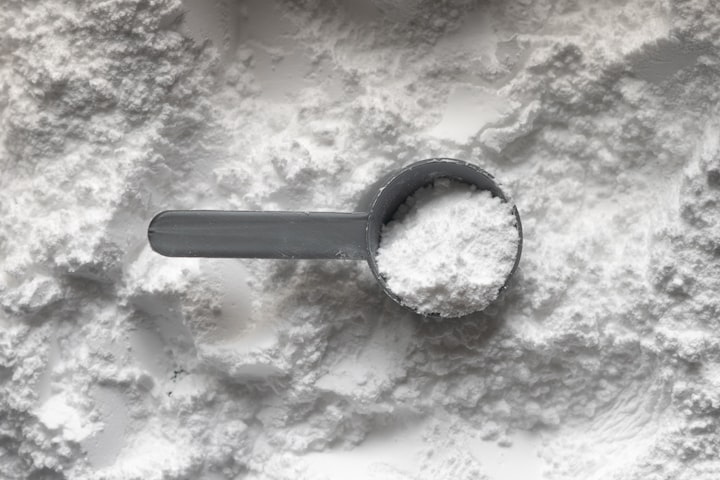Creatine: action, dosage and side effects
Creatine is the most well-known and proven sports supplement. We owe our discovery (in 1832) to the French chemist Michel Eugene Chevreul. And the name of this chemical comes from the Greek word "kreas", which means meat. Gym adepts attribute this mainly to the effects on muscle building and water retention. In this text, I will present the most important information about creatine with reference to scientific sources.
What is creatine?
Creatine is a chemical compound made up of three amino acids: arginine, glycine and methionine. It occurs naturally in the human body and is mainly produced in the liver. Creatine is transported to muscle cells through the blood. There it combines with phosphate to form phosphocreatine. Phosphocreatine is broken down in muscle cells to form ATP (or energy). The process briefly described above is called the ATP-PC energy pathway.
This path is characterized by a very rapid release of energy. We use it during peak bursts of activity that last no more than 6 seconds . For example, starting a sprint, bench press, or quick kick are actions that the body feeds in this way. If you come across a wild boar in the forest and start running away at breakneck speed, it is thanks to creatine.
Creatine - Food Sources
Creatine is found in pork, beef, and fish (such as salmon, cod, tuna). Unfortunately, the amount of creatine in food is low. For example, a pound of beef steak contains about 5 grams of creatine , which is as much as a standard added dose. Eating such a piece of meat is not easy, not to mention the cost of such a “natural” supplement. This is why it is most convenient to take creatine. Getting it from food is difficult and expensive. The main sources of creatine in food are pork, beef and fish.
Effects of creatine supplementation
Taking creatine supplements has the following effects-
- Creatine increases the amount of phosphocreatine (PC) in the muscles. Consequently, the body has more reserves of "emergency energy potential". As a result: You can do high-intensity exercises (sprinting, weightlifting, etc.) for longer and your muscle strength increases.
- Taking creatine leads to the accumulation of water in the cells. More precisely: creatine increases the penetration of water through cell membranes (the thickness of muscle fibers increases by about 15%). This means that it actually increases lean body mass (however, this should not be confused with increasing muscle mass). "Pumping" water into the muscles leads not only to a change in their appearance, but also has a beneficial effect on protein production and muscle growth.
- Creatine removes excess hydrogen ions, reducing muscle acidity. As a result, during exercise, the body later produces more lactic acid in the muscles.
Simply put. Creatine supplementation helps: increase muscle strength and endurance, helps accelerate muscle growth (among other things, because with increasing strength we can lift heavier weights and stimulate muscles to grow stronger). Finally, creatine promotes water retention in the body.
However, it's worth noting that creatine works differently for everyone. Each organism has its own "chemistry". There are also people for whom creatine supplements work poorly or not at all.
What are the side effects of creatine? / Is creatine safe?
You can read a lot of information on the Internet about the alleged dangers of creatine supplementation. Mention, for example, of harm to the kidneys and the simultaneous recommendation to drink "huge amounts of water" - I wonder if you are taking something harmful to the kidneys, why burden them even more with the use of "huge amounts of water"?
At the same time, I emphasize the expression “huge amount of water” (for a person involved in sports, 3-4 liters per day (or even 5 liters) is the norm, so “huge amounts” can be as little as 10 liters per day (if you are serious to the recommendations of creatine-frightened people.) Other conspiracy theories in history say formaldehyde is deposited in the body as a result of creatine ingestion , but none of these theories are supported by scientific research .
An example of a study on the safety of creatine supplementation
In 2005, a study appeared in the International Journal of Sports Medicine that examined the health effects of creatine monohydrate supplementation. The study involved 175 people aged about 57 years (in addition, obese people had neurodegenerative diseases).
Subjects were injected with 10 g of creatine monohydrate daily (i.e., twice the standard recommended dose) for 310 days. After the end of the study, no effects of creatine monohydrate supplementation on their health were noted. During the experiment, three people had to be abandoned: two due to diarrhea and one due to nausea. In short, 3 out of 175 respondents showed health problems due to creatine intake (source).
In 2002, the International Journal of Sports Nutrition and Exercise Metabolism published a study examining the effects of long-term creatine supplementation on the kidneys. This time, the study was conducted on the players of the football team.
As you can imagine, they have not shown any harmful effects of creatine on the kidneys (source). Other research even shows that creatine supplementation does not affect kidney health in people with type 2 diabetes.
However, it is not recommended to use creatine for people with kidney, liver problems or diabetics (in any case, if you have health problems, you should first consult a doctor). It is a commonly used supplement by people involved in a variety of sports.
Do you need to use creatine?
The answer to this question depends mainly on what kind of sport you are involved in. If you exercise (or want to work out in the gym), creatine is definitely a good choice. Likewise, for example, in the case of sprinters, people doing pole vaulting, etc.
Creatine is not recommended for people who play sports in which the main energy pathway is oxygen metabolism. In Polish: people who practice, for example, long-distance running and other sports in which there are practically no sudden jumps and increased movement.
How to dose creatine?
By searching the Internet, you can find many concepts for creatine “loading”. Magazines of this type may look different, but something like this: "first 5 days: 4x6g, then .". Unfortunately, these methods don't make a lot of sense, mainly because when you consume so much creatine, most of it is excreted in the urine. It is true that the creatine pumping effect will be achieved, but it is a waste of money. Better to do it a little slower and cheaper. The simplest strategy is to take several smaller doses of creatine per day. The usual recommended daily intake of creatine is 5 g (for example, in 4 capsules).
It is also worth remembering that insulin promotes better absorption of creatine. Therefore, it is highly recommended to take creatine immediately after exercise due to the rise in insulin levels after exercise. It's also worth taking creatine with or immediately after a meal (insulin argument again) (source). Simply put: Creatine should be taken along with carbohydrates because it increases the rate at which it is absorbed (source). Consuming creatine with protein (such as a protein shake) also appears to have a positive effect on its absorption (source).
On the packaging of products containing creatine, you can find all sorts of suggestions for when to take it. Personally, I suggest taking creatine with breakfast and right after your workout. And on non-workout days during breakfast and lunch. Alternatively, you can split your creatine intake into other meals throughout the day. Creatine stimulates some people, so it is better to be careful when using it at night (personally, it never interfered with the process of falling asleep).
Creatine cycles or how long should I use creatine?
I would hate to open Pandora's box to write about it. There are many approaches to the creatine cycle. Some say creatine can be taken all the time. I am not a supporter of the latter approach, because this is a food supplement and it is worth giving the body a break from it for a while. Without further discussion, I run my creatine cycles as follows: I take creatine regularly for 3 months, then take a break for 1 month. I do not use any creatine "load", I take only a constant dose (about 5 g) per day.
Creatine to reduce
Creatine is a dietary supplement associated primarily with the period of body weight. However, the use of creatine during periods when we are working on burning fat is not pointless. During the decline, there is often a drop in strength, if we have previously taken creatine and then stop it to decrease (i.e. simultaneously reduce calories), the decline in strength can already be severe.
In addition, water retention increases our lean body mass, and in theory, this should increase the base calorie requirement for BMR. Even if that were the case, the difference would be negligible.
Which creatine should you choose?
The most "true" form of creatine is creatine monohydrate. Therefore, when buying a dietary supplement with creatine, you should pay attention to whether this form of creatine is present in it at all.
There are also supplements with various forms of creatine (called "matrices" or "stacks"). Keep in mind, however, that the only proven and reliable form of creatine is monohydrate. All creatine malates, creatine citrates, etc. are purely marketing products. Below is a list of creatine monohydrate foods that I consider to be recommended.
What creatine do I use?
Personally, I use Optimum Nutrition's Micronized Creatine Monohydrate, photo of which (packaging and interior are visible in the photo on the right). I chose this particular product for several reasons. First of all, if you look at the ingredients on the packaging, you will only find creatine monohydrate on the list.
In other words: it is a 100% condensed product with no fillers. The second question is "micro-rework". If you were to take some creatine powder in your hand, you would very quickly notice that it is not fluid , that the creatine is so finely divided that it just sticks to your hand. The degree of fragmentation is, of course, important for the absorption of creatine. Micronization also contributes to very good solubilityof this product (I have never had any lumps or leftovers).
The last argument ("last but not least") is the producer himself. Optimum Nutrition is a brand that I especially trust. In Poland, he is a little less well known. Their protein supplement is the bestseller in the US (one might say it is the "Lord of the Rings" of protein supplements). Optimum Nutrition products pass all independent benchmarking tests (and given the US market, every competitor is constantly on the lookout for the other to find a hook).
The creatine monohydrate I use comes in several flavors: tablets, 317g powder packs, and 634g packs. As many as 3 grams of creatine monohydrate from the same manufacturer can be found in the Gold Pre-workout serving (which I also use) .







Comments
There are no comments for this story
Be the first to respond and start the conversation.